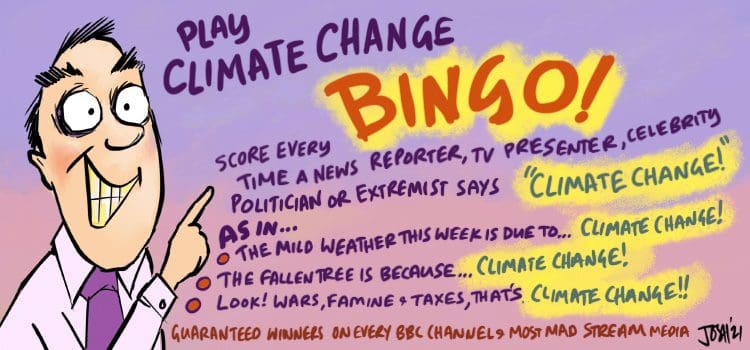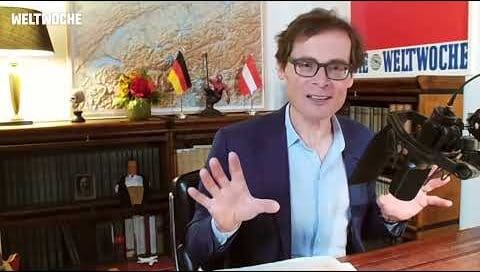

Net Zero Activists Redefine What Counts as Scientific Proof
The ‘Holy Grail’ of politicised climate science is the attribution of single weather events to the unproven hypothesis that humans cause all or most climate change. Like the Holy Grail, it is beyond reach – simply put, it is impossible to attribute a sunny, or rainy, day to long-term climate trends. There are countless influences on the Earth’s atmosphere, many beyond current scientific computation. Despite considerable effort, no ‘attribution’ study proves human involvement, and the suggestions remain little more than imaginative opinion.
But with the growing realisation that global warming has been running out of steam for the last couple of decades, extreme weather events, along with associated ‘tipping points’, are a vital weapon in the drive to politicise climate science, and push forward the command-and-control Net Zero agenda. Difficult, nay impossible, to prove. But happily for the Net Zero activists, help is at hand. Last year, professors Elisabeth Lloyd, Naomi Oreskes and others wrote a paper calling for the level of proof when it comes to the wild claims made by climate change activists should be lowered to “more likely than not”. Climate scientists are said to set the bar “too high” when it comes to proving their claims, thereby conceding too much ground to the ‘deniers’. “In our view, the too narrow focus of climate science on extremely stringent levels of proofs is damaging in a legal context, and can lead to confusion when communicating scientific findings more generally,” they wrote.
Without apparent irony, the authors of the paper point out that a much lower standard of proof was required before cities or entire states were locked down to supposedly slow the spread of coronavirus and argue that the same “level of evidence” should apply when it comes to forcing people to reduce their carbon emissions:
Consider our situation with the coronavirus. We often have to make a variety of policy, practical, and legal decisions based on incomplete information, which also depend on judgements about whether the evidence is good enough. What level of evidence do we need, in the case of the coronavirus, to order a stay-at-home command for an entire city or state? What is the level of evidence required to actively prepare for catastrophic needs for intensive care units in hospitals? If there is an immediate and/or grave threat, as we have seen, it may be better to act on a lower level of evidence than we might otherwise expect.
The philosophers don’t appear to have spotted the circularity in this argument: We should apply lower standard of proof when it comes to assessing claims made by climate change activists because climate change poses an immediate and/or grave threat. How do we know it poses such a threat? Because when it comes to assessing such claims we should apply a lower standard of proof.
Elizabeth Lloyd of Indiana University and Naomi Oreskes of Harvard are both philosophers and historians, and both are highly influential in green activist academic circles. But their scientific philosophy runs counter to the principles set out by the legendary Professor Karl Popper who outlined the basis for today’s widely accepted empirical scientific method. He held that scientific knowledge is only ever ‘provisional’ and, to count as a legitimate, it must be ‘falsifiable’, i.e., capable of being proved false. Hard to see how a scientific hypothesis that is “more likely than not” to be true could be falsified. Citing a fact that was at odds with it could just be added to the “not” column without necessarily tipping the scales against it.
Activists have long harboured ambitions to use the courts to further their aims, where civil claims are usually decided on the “preponderance of evidence” rather than conclusive proof for or against. According to Lloyd and Oreskes, “Scientists typically demand too much of themselves in terms of evidence, in comparison with the level of evidence required in a legal, regulatory, or public policy context.” Stringent levels of proof are said by them to be “damaging”, and can lead to “confusion” when communicating scientific findings to the lay public.
This is an odd argument. After all, if tens of millions of people are definitely going to be made poorer by a climate policy – Net Zero, for instance – surely we need to know with a reasonable degree of certainty that not reducing carbon emissions to zero by 2050 would be even more damaging to people’s welfare, not just that it is “more likely than not”? The difficulty is that the harm caused by Net Zero is immediate and tangible, whereas the harm caused by not implementing Net Zero is speculative and notional.
It won’t come as a surprise that Lloyd and Oreskes are both keen on climate models. “Climate models aid in the attribution of extreme events both through the probabilistic and storyline or mechanistic methods; in both cases, extreme events such as heat waves or heavy precipitation events can generally be attributed to climate change with a high degree of confidence”, they write. Such “advances”, they suggest, “have allowed such analyses to be used as evidence in legal cases involving climate change”.
Overall, the writers suggest that “more likely than not” be considered sufficient proof when it comes to any claims made by climate change activists, including attributing one-off events to anthropogenic global warming. “[I]ts use would increase the odds that the audience for IPCC information understands climate evidence as the IPCC intends it to,“ they write. “Indeed, our argument also applies beyond courtrooms, and more generally to the public discourse on climate change.”
How very thoughtful of them. Let’s hope climate activists don’t apply the same standard of ‘proof’ when it comes to imprisoning climate change ‘deniers’ for challenging the prevailing orthodoxy. Two years ago, Exeter University associate geography professor Saffron O’Neill said a “solution” to the dissemination of climate misinformation might be “fines and imprisonment”. Misinformation was defined as casting doubt on “well supported” science. Casting doubt on dodgy climate forecasts that are “more likely than not” to be true? Time for a spell of model re-education in Maximum Security.
Chris Morrison is the Daily Sceptic’s Environment Editor.







